Research Project: Impact of Outsourcing Staffing on Organizations
VerifiedAdded on 2020/04/01
|13
|2659
|51
Project
AI Summary
This project proposal investigates the impact of outsourcing the staffing function on business organizations in Australia. It begins with an introduction to outsourcing, defining it as delegating non-core functions to external companies. The project aims to identify the reasons behind outsourcing staffing, its benefits, and shortcomings. The scope is wide, examining both positive and negative effects. The proposal justifies the research by highlighting the increasing popularity of HR outsourcing and the limited information available on its specific impacts. A literature review explores cost-saving motivations, efficiency gains, and various outsourcing models like SaaS and business process outsourcing. The review also identifies potential benefits such as reduced costs, increased efficiency, and access to specialized expertise, while acknowledging potential drawbacks like loss of control and demotivated employees. Research questions address the impact on efficiency, cost reduction, and employee motivation. The methodology combines qualitative research, including analysis of journal articles and ethnography, with quantitative research using financial data and statistical analysis. The proposal outlines a research plan and acknowledges potential limitations, such as time constraints and data accuracy. The project aims to provide valuable insights into the effects of outsourcing staffing functions on organizations in Australia.
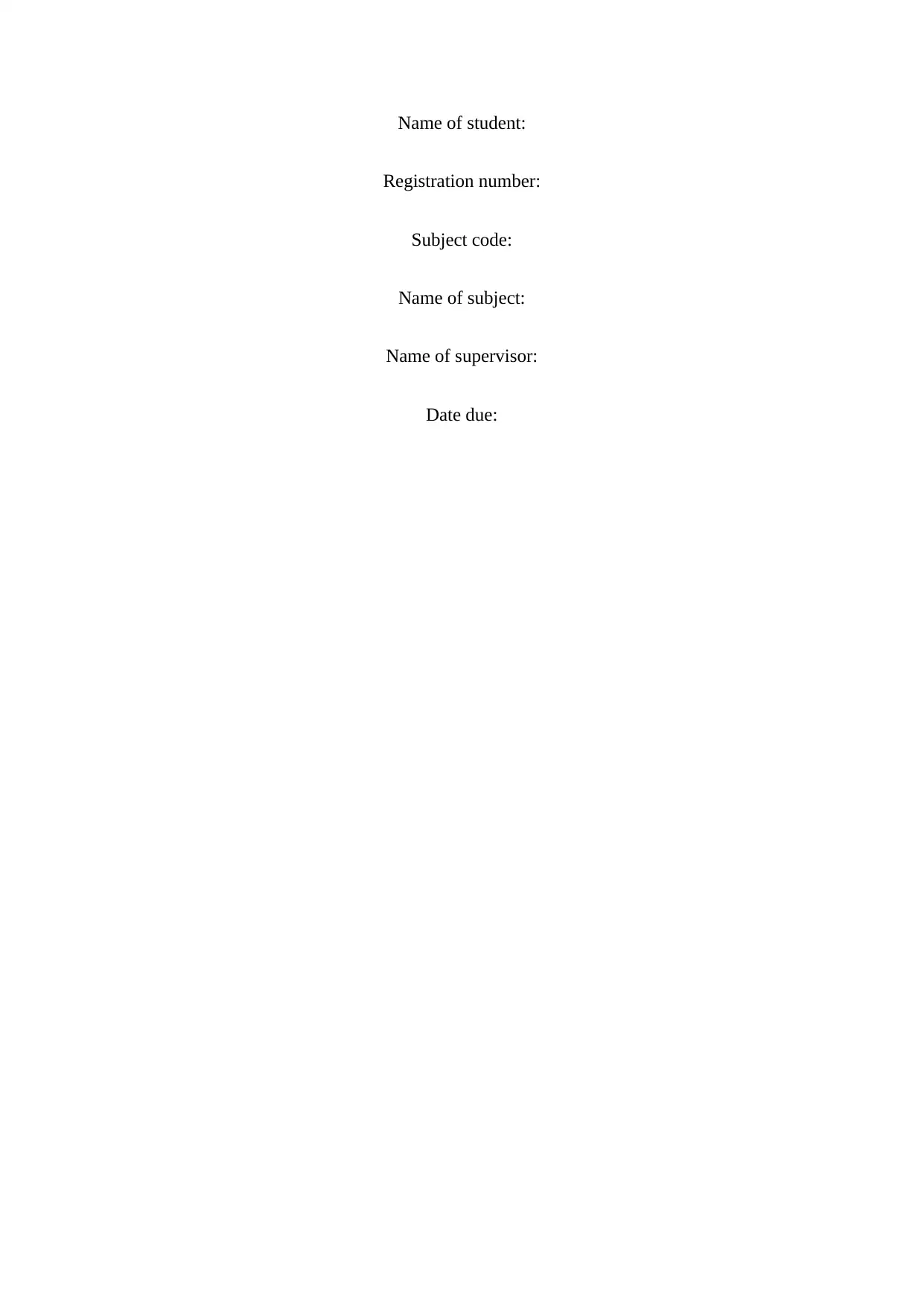
Name of student:
Registration number:
Subject code:
Name of subject:
Name of supervisor:
Date due:
Registration number:
Subject code:
Name of subject:
Name of supervisor:
Date due:
Secure Best Marks with AI Grader
Need help grading? Try our AI Grader for instant feedback on your assignments.
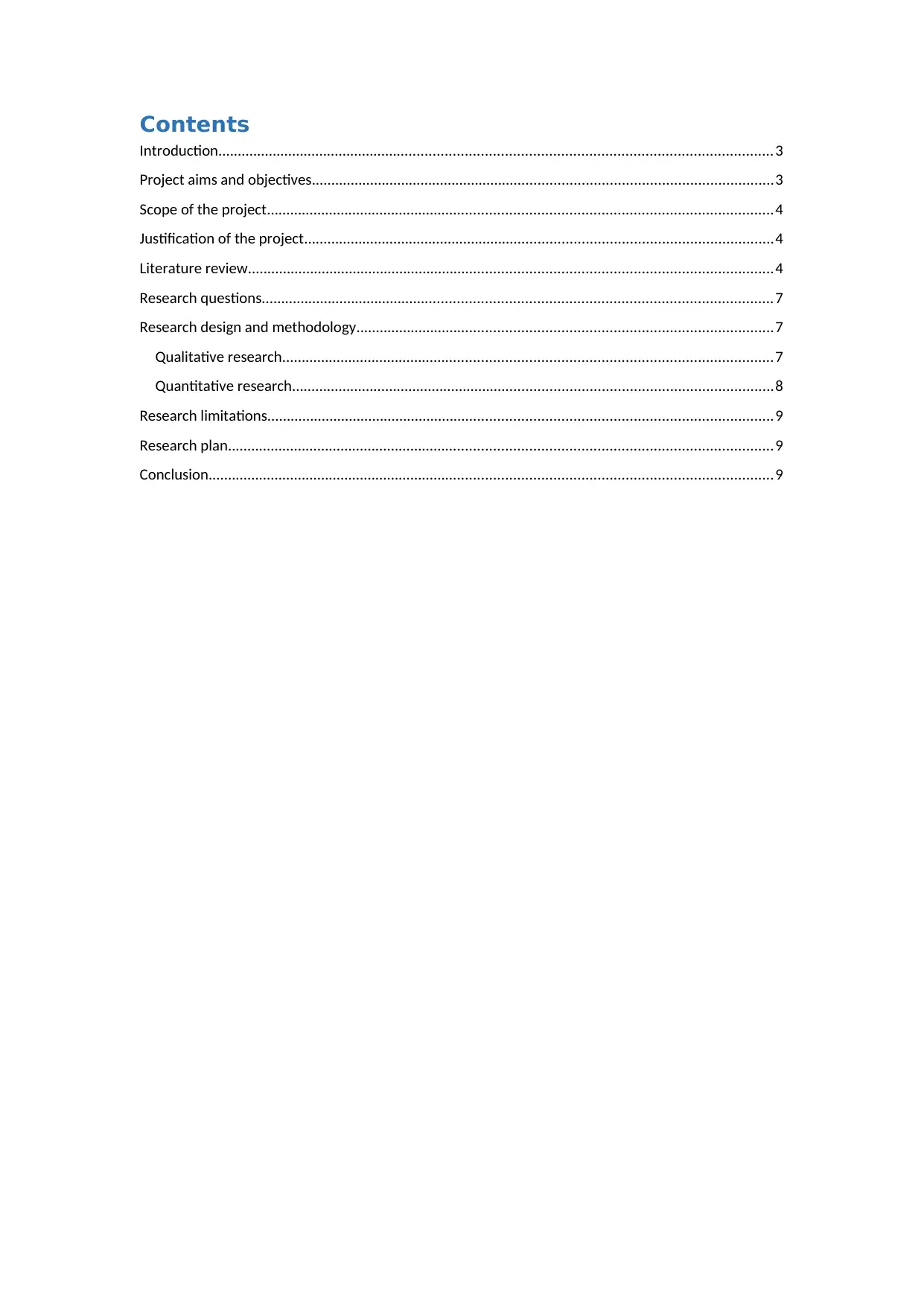
Contents
Introduction............................................................................................................................................3
Project aims and objectives.....................................................................................................................3
Scope of the project................................................................................................................................4
Justification of the project.......................................................................................................................4
Literature review.....................................................................................................................................4
Research questions.................................................................................................................................7
Research design and methodology.........................................................................................................7
Qualitative research............................................................................................................................7
Quantitative research..........................................................................................................................8
Research limitations................................................................................................................................9
Research plan..........................................................................................................................................9
Conclusion...............................................................................................................................................9
Introduction............................................................................................................................................3
Project aims and objectives.....................................................................................................................3
Scope of the project................................................................................................................................4
Justification of the project.......................................................................................................................4
Literature review.....................................................................................................................................4
Research questions.................................................................................................................................7
Research design and methodology.........................................................................................................7
Qualitative research............................................................................................................................7
Quantitative research..........................................................................................................................8
Research limitations................................................................................................................................9
Research plan..........................................................................................................................................9
Conclusion...............................................................................................................................................9
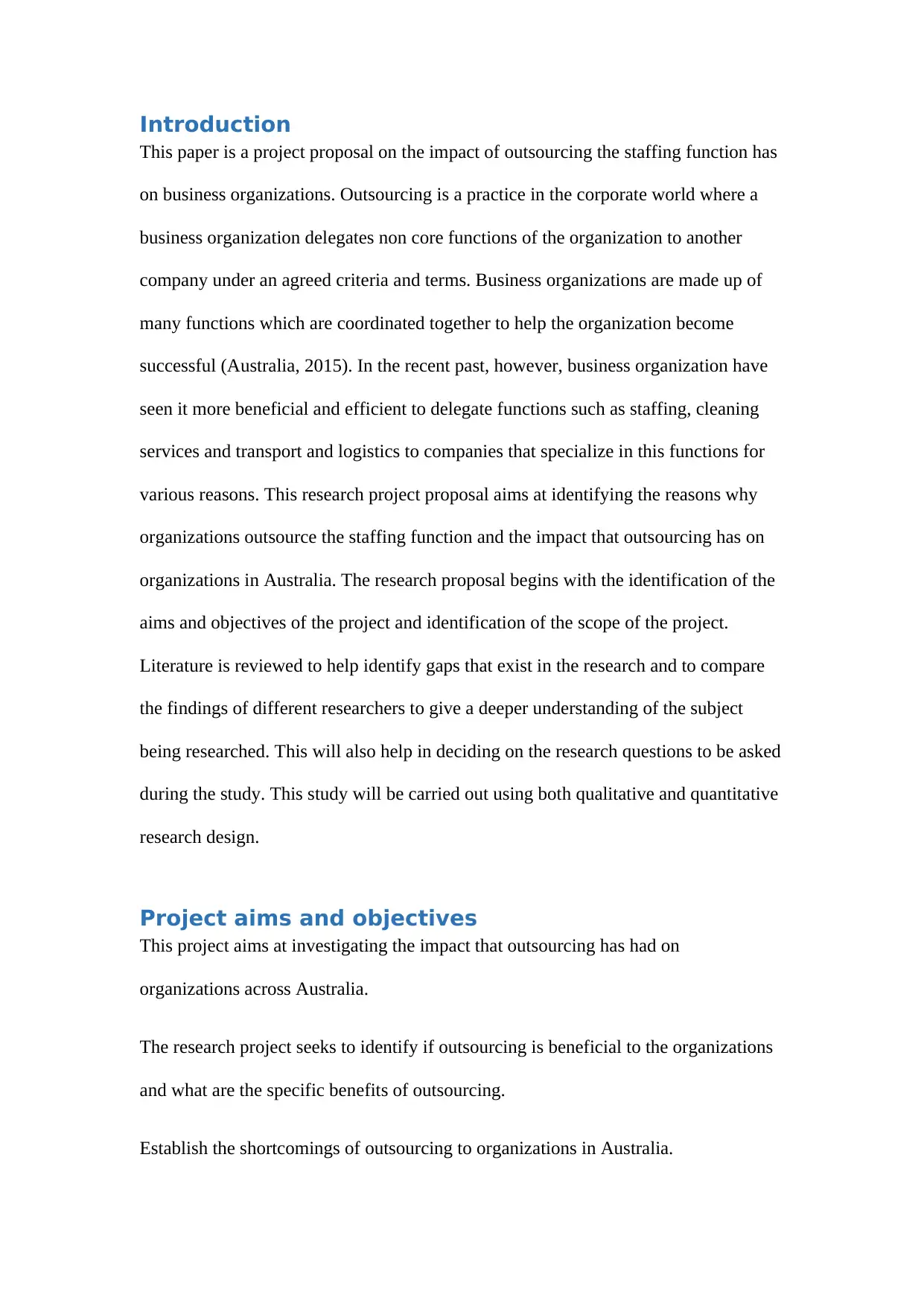
Introduction
This paper is a project proposal on the impact of outsourcing the staffing function has
on business organizations. Outsourcing is a practice in the corporate world where a
business organization delegates non core functions of the organization to another
company under an agreed criteria and terms. Business organizations are made up of
many functions which are coordinated together to help the organization become
successful (Australia, 2015). In the recent past, however, business organization have
seen it more beneficial and efficient to delegate functions such as staffing, cleaning
services and transport and logistics to companies that specialize in this functions for
various reasons. This research project proposal aims at identifying the reasons why
organizations outsource the staffing function and the impact that outsourcing has on
organizations in Australia. The research proposal begins with the identification of the
aims and objectives of the project and identification of the scope of the project.
Literature is reviewed to help identify gaps that exist in the research and to compare
the findings of different researchers to give a deeper understanding of the subject
being researched. This will also help in deciding on the research questions to be asked
during the study. This study will be carried out using both qualitative and quantitative
research design.
Project aims and objectives
This project aims at investigating the impact that outsourcing has had on
organizations across Australia.
The research project seeks to identify if outsourcing is beneficial to the organizations
and what are the specific benefits of outsourcing.
Establish the shortcomings of outsourcing to organizations in Australia.
This paper is a project proposal on the impact of outsourcing the staffing function has
on business organizations. Outsourcing is a practice in the corporate world where a
business organization delegates non core functions of the organization to another
company under an agreed criteria and terms. Business organizations are made up of
many functions which are coordinated together to help the organization become
successful (Australia, 2015). In the recent past, however, business organization have
seen it more beneficial and efficient to delegate functions such as staffing, cleaning
services and transport and logistics to companies that specialize in this functions for
various reasons. This research project proposal aims at identifying the reasons why
organizations outsource the staffing function and the impact that outsourcing has on
organizations in Australia. The research proposal begins with the identification of the
aims and objectives of the project and identification of the scope of the project.
Literature is reviewed to help identify gaps that exist in the research and to compare
the findings of different researchers to give a deeper understanding of the subject
being researched. This will also help in deciding on the research questions to be asked
during the study. This study will be carried out using both qualitative and quantitative
research design.
Project aims and objectives
This project aims at investigating the impact that outsourcing has had on
organizations across Australia.
The research project seeks to identify if outsourcing is beneficial to the organizations
and what are the specific benefits of outsourcing.
Establish the shortcomings of outsourcing to organizations in Australia.
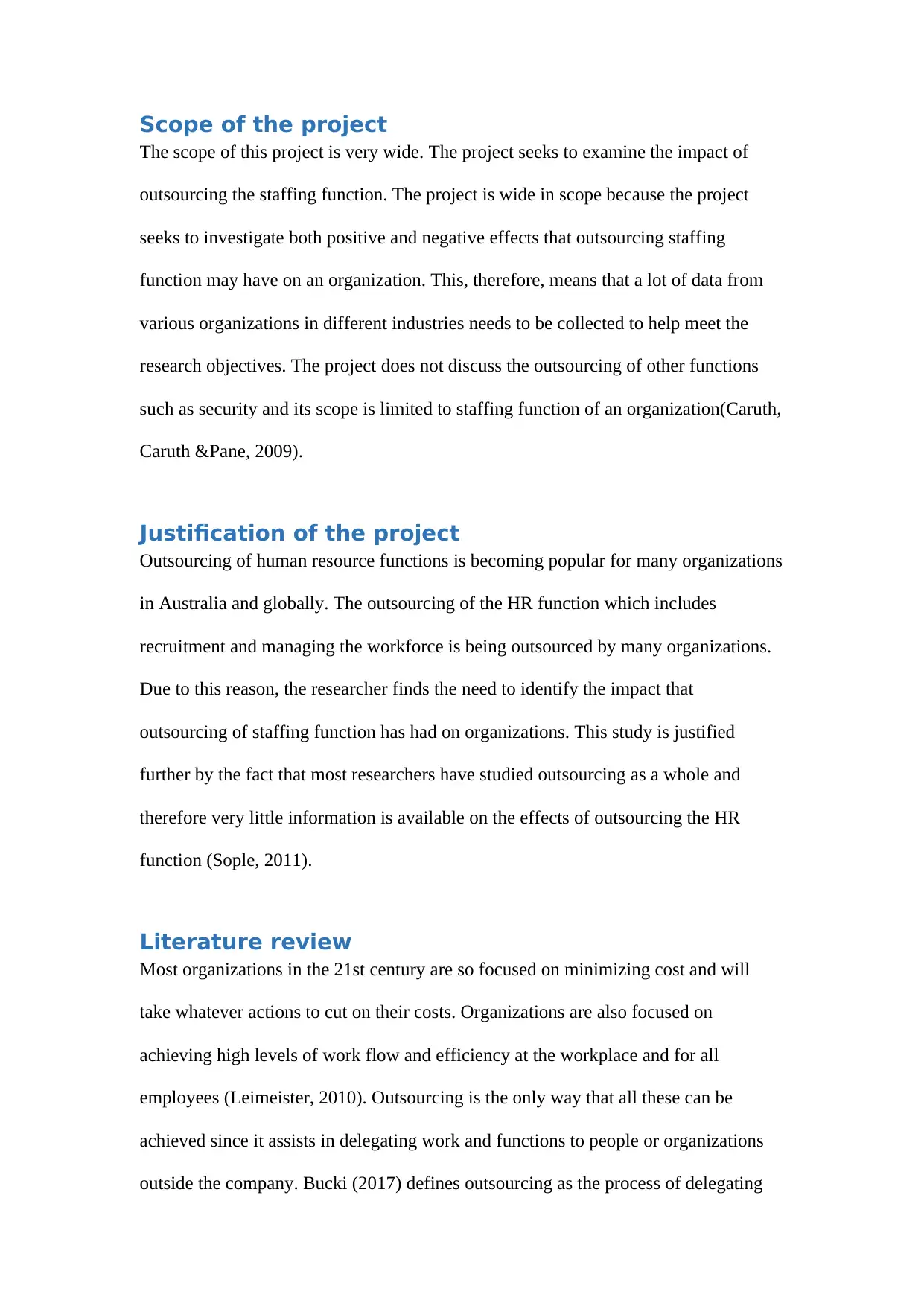
Scope of the project
The scope of this project is very wide. The project seeks to examine the impact of
outsourcing the staffing function. The project is wide in scope because the project
seeks to investigate both positive and negative effects that outsourcing staffing
function may have on an organization. This, therefore, means that a lot of data from
various organizations in different industries needs to be collected to help meet the
research objectives. The project does not discuss the outsourcing of other functions
such as security and its scope is limited to staffing function of an organization(Caruth,
Caruth &Pane, 2009).
Justification of the project
Outsourcing of human resource functions is becoming popular for many organizations
in Australia and globally. The outsourcing of the HR function which includes
recruitment and managing the workforce is being outsourced by many organizations.
Due to this reason, the researcher finds the need to identify the impact that
outsourcing of staffing function has had on organizations. This study is justified
further by the fact that most researchers have studied outsourcing as a whole and
therefore very little information is available on the effects of outsourcing the HR
function (Sople, 2011).
Literature review
Most organizations in the 21st century are so focused on minimizing cost and will
take whatever actions to cut on their costs. Organizations are also focused on
achieving high levels of work flow and efficiency at the workplace and for all
employees (Leimeister, 2010). Outsourcing is the only way that all these can be
achieved since it assists in delegating work and functions to people or organizations
outside the company. Bucki (2017) defines outsourcing as the process of delegating
The scope of this project is very wide. The project seeks to examine the impact of
outsourcing the staffing function. The project is wide in scope because the project
seeks to investigate both positive and negative effects that outsourcing staffing
function may have on an organization. This, therefore, means that a lot of data from
various organizations in different industries needs to be collected to help meet the
research objectives. The project does not discuss the outsourcing of other functions
such as security and its scope is limited to staffing function of an organization(Caruth,
Caruth &Pane, 2009).
Justification of the project
Outsourcing of human resource functions is becoming popular for many organizations
in Australia and globally. The outsourcing of the HR function which includes
recruitment and managing the workforce is being outsourced by many organizations.
Due to this reason, the researcher finds the need to identify the impact that
outsourcing of staffing function has had on organizations. This study is justified
further by the fact that most researchers have studied outsourcing as a whole and
therefore very little information is available on the effects of outsourcing the HR
function (Sople, 2011).
Literature review
Most organizations in the 21st century are so focused on minimizing cost and will
take whatever actions to cut on their costs. Organizations are also focused on
achieving high levels of work flow and efficiency at the workplace and for all
employees (Leimeister, 2010). Outsourcing is the only way that all these can be
achieved since it assists in delegating work and functions to people or organizations
outside the company. Bucki (2017) defines outsourcing as the process of delegating
Secure Best Marks with AI Grader
Need help grading? Try our AI Grader for instant feedback on your assignments.
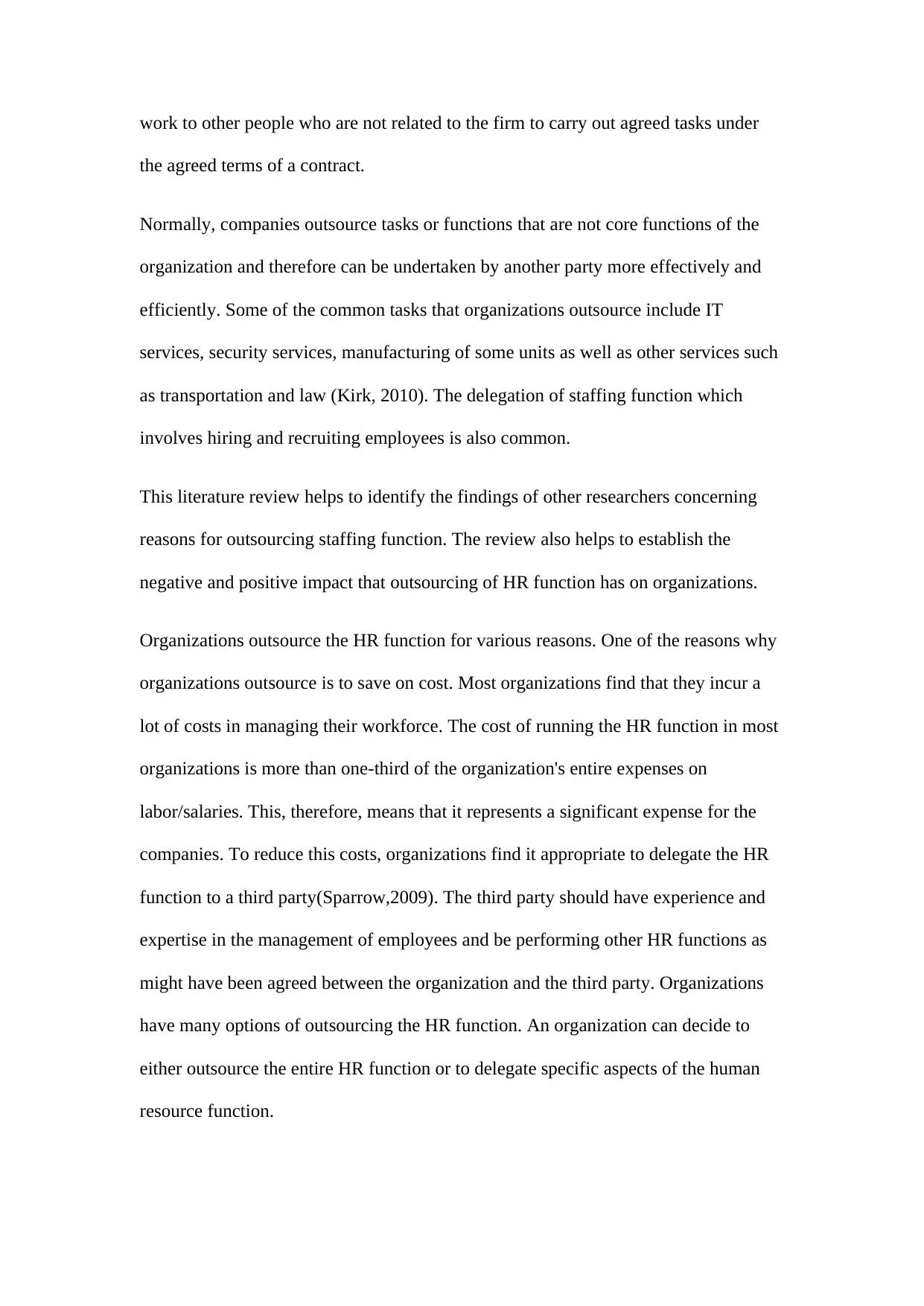
work to other people who are not related to the firm to carry out agreed tasks under
the agreed terms of a contract.
Normally, companies outsource tasks or functions that are not core functions of the
organization and therefore can be undertaken by another party more effectively and
efficiently. Some of the common tasks that organizations outsource include IT
services, security services, manufacturing of some units as well as other services such
as transportation and law (Kirk, 2010). The delegation of staffing function which
involves hiring and recruiting employees is also common.
This literature review helps to identify the findings of other researchers concerning
reasons for outsourcing staffing function. The review also helps to establish the
negative and positive impact that outsourcing of HR function has on organizations.
Organizations outsource the HR function for various reasons. One of the reasons why
organizations outsource is to save on cost. Most organizations find that they incur a
lot of costs in managing their workforce. The cost of running the HR function in most
organizations is more than one-third of the organization's entire expenses on
labor/salaries. This, therefore, means that it represents a significant expense for the
companies. To reduce this costs, organizations find it appropriate to delegate the HR
function to a third party(Sparrow,2009). The third party should have experience and
expertise in the management of employees and be performing other HR functions as
might have been agreed between the organization and the third party. Organizations
have many options of outsourcing the HR function. An organization can decide to
either outsource the entire HR function or to delegate specific aspects of the human
resource function.
the agreed terms of a contract.
Normally, companies outsource tasks or functions that are not core functions of the
organization and therefore can be undertaken by another party more effectively and
efficiently. Some of the common tasks that organizations outsource include IT
services, security services, manufacturing of some units as well as other services such
as transportation and law (Kirk, 2010). The delegation of staffing function which
involves hiring and recruiting employees is also common.
This literature review helps to identify the findings of other researchers concerning
reasons for outsourcing staffing function. The review also helps to establish the
negative and positive impact that outsourcing of HR function has on organizations.
Organizations outsource the HR function for various reasons. One of the reasons why
organizations outsource is to save on cost. Most organizations find that they incur a
lot of costs in managing their workforce. The cost of running the HR function in most
organizations is more than one-third of the organization's entire expenses on
labor/salaries. This, therefore, means that it represents a significant expense for the
companies. To reduce this costs, organizations find it appropriate to delegate the HR
function to a third party(Sparrow,2009). The third party should have experience and
expertise in the management of employees and be performing other HR functions as
might have been agreed between the organization and the third party. Organizations
have many options of outsourcing the HR function. An organization can decide to
either outsource the entire HR function or to delegate specific aspects of the human
resource function.
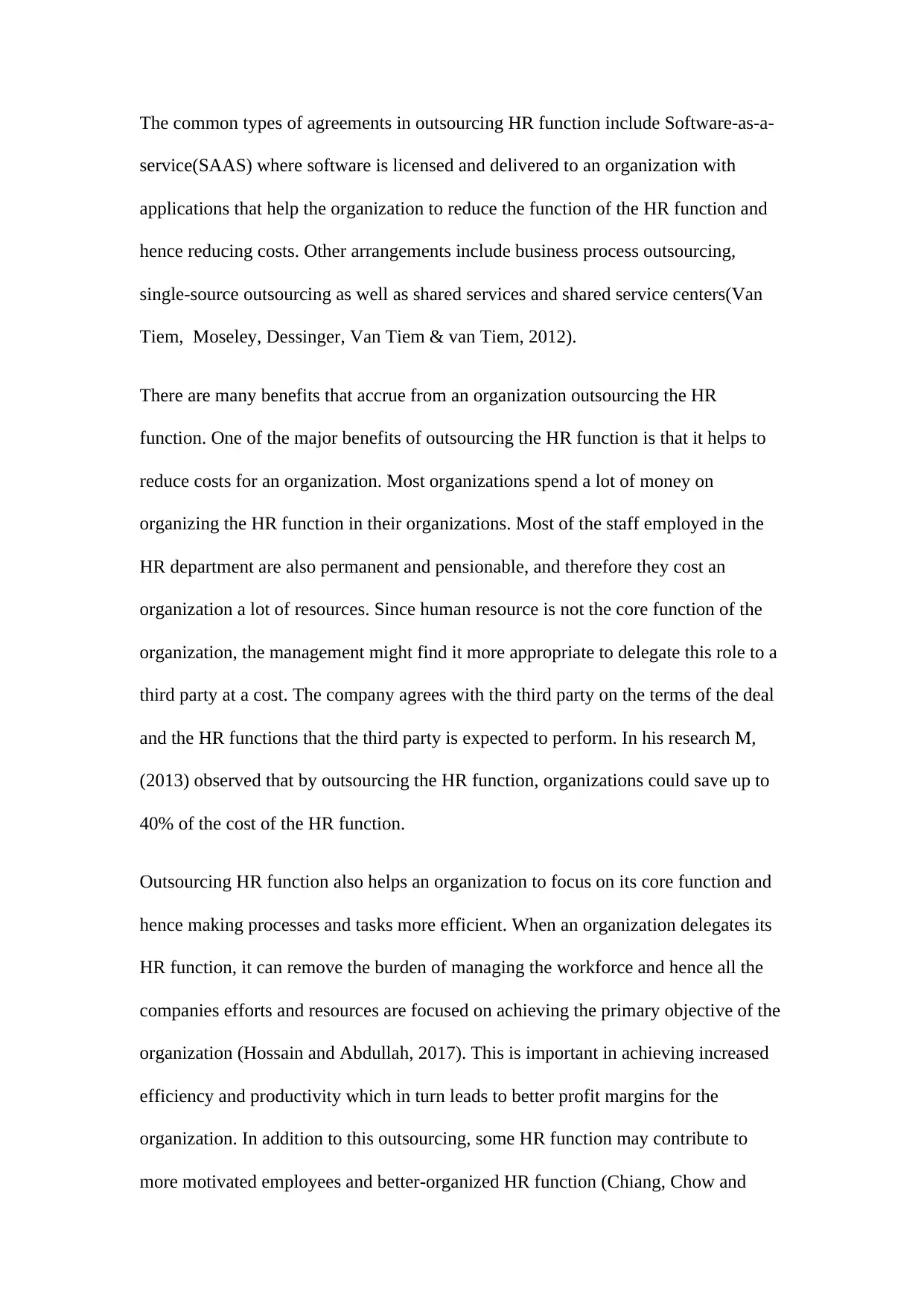
The common types of agreements in outsourcing HR function include Software-as-a-
service(SAAS) where software is licensed and delivered to an organization with
applications that help the organization to reduce the function of the HR function and
hence reducing costs. Other arrangements include business process outsourcing,
single-source outsourcing as well as shared services and shared service centers(Van
Tiem, Moseley, Dessinger, Van Tiem & van Tiem, 2012).
There are many benefits that accrue from an organization outsourcing the HR
function. One of the major benefits of outsourcing the HR function is that it helps to
reduce costs for an organization. Most organizations spend a lot of money on
organizing the HR function in their organizations. Most of the staff employed in the
HR department are also permanent and pensionable, and therefore they cost an
organization a lot of resources. Since human resource is not the core function of the
organization, the management might find it more appropriate to delegate this role to a
third party at a cost. The company agrees with the third party on the terms of the deal
and the HR functions that the third party is expected to perform. In his research M,
(2013) observed that by outsourcing the HR function, organizations could save up to
40% of the cost of the HR function.
Outsourcing HR function also helps an organization to focus on its core function and
hence making processes and tasks more efficient. When an organization delegates its
HR function, it can remove the burden of managing the workforce and hence all the
companies efforts and resources are focused on achieving the primary objective of the
organization (Hossain and Abdullah, 2017). This is important in achieving increased
efficiency and productivity which in turn leads to better profit margins for the
organization. In addition to this outsourcing, some HR function may contribute to
more motivated employees and better-organized HR function (Chiang, Chow and
service(SAAS) where software is licensed and delivered to an organization with
applications that help the organization to reduce the function of the HR function and
hence reducing costs. Other arrangements include business process outsourcing,
single-source outsourcing as well as shared services and shared service centers(Van
Tiem, Moseley, Dessinger, Van Tiem & van Tiem, 2012).
There are many benefits that accrue from an organization outsourcing the HR
function. One of the major benefits of outsourcing the HR function is that it helps to
reduce costs for an organization. Most organizations spend a lot of money on
organizing the HR function in their organizations. Most of the staff employed in the
HR department are also permanent and pensionable, and therefore they cost an
organization a lot of resources. Since human resource is not the core function of the
organization, the management might find it more appropriate to delegate this role to a
third party at a cost. The company agrees with the third party on the terms of the deal
and the HR functions that the third party is expected to perform. In his research M,
(2013) observed that by outsourcing the HR function, organizations could save up to
40% of the cost of the HR function.
Outsourcing HR function also helps an organization to focus on its core function and
hence making processes and tasks more efficient. When an organization delegates its
HR function, it can remove the burden of managing the workforce and hence all the
companies efforts and resources are focused on achieving the primary objective of the
organization (Hossain and Abdullah, 2017). This is important in achieving increased
efficiency and productivity which in turn leads to better profit margins for the
organization. In addition to this outsourcing, some HR function may contribute to
more motivated employees and better-organized HR function (Chiang, Chow and
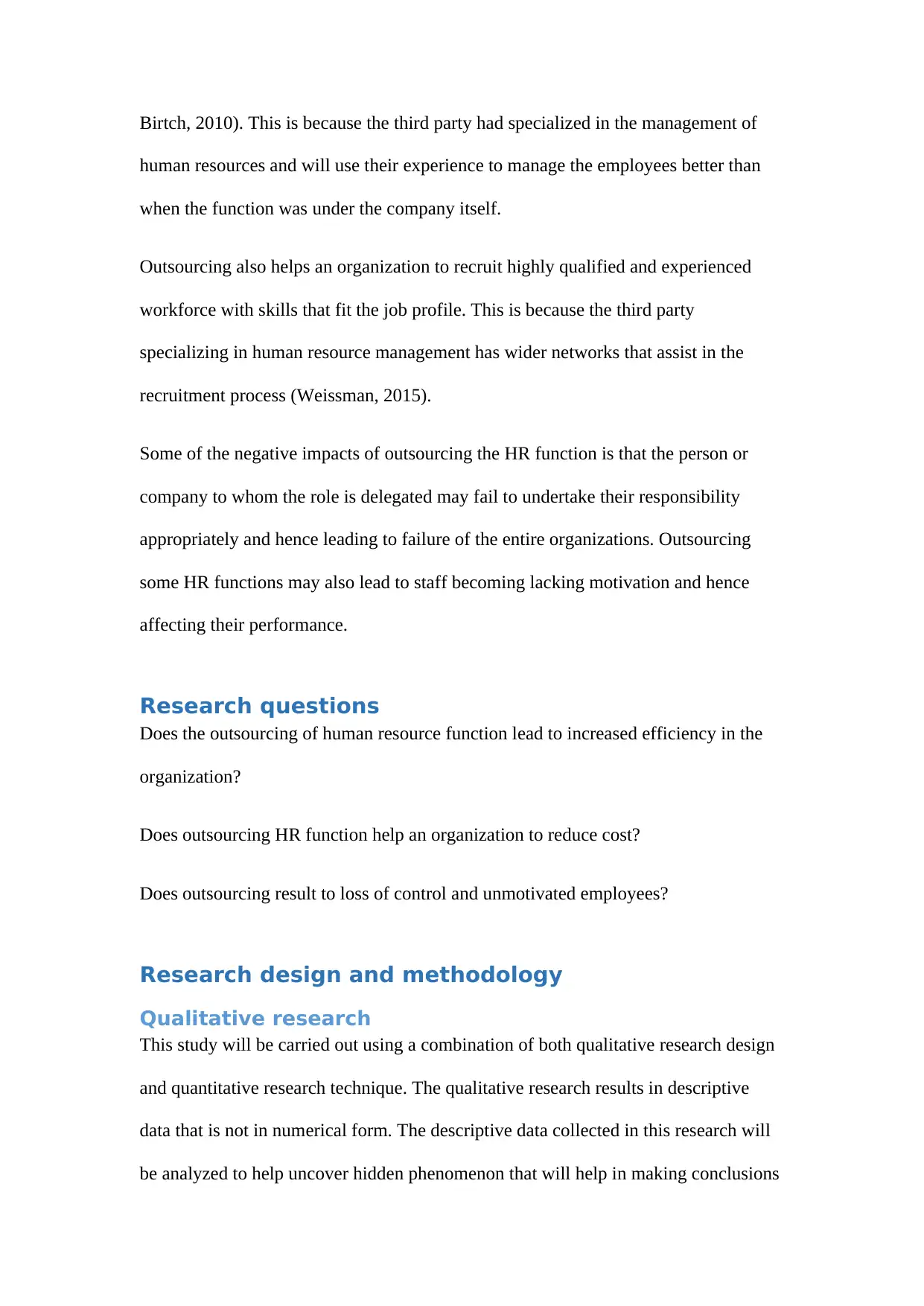
Birtch, 2010). This is because the third party had specialized in the management of
human resources and will use their experience to manage the employees better than
when the function was under the company itself.
Outsourcing also helps an organization to recruit highly qualified and experienced
workforce with skills that fit the job profile. This is because the third party
specializing in human resource management has wider networks that assist in the
recruitment process (Weissman, 2015).
Some of the negative impacts of outsourcing the HR function is that the person or
company to whom the role is delegated may fail to undertake their responsibility
appropriately and hence leading to failure of the entire organizations. Outsourcing
some HR functions may also lead to staff becoming lacking motivation and hence
affecting their performance.
Research questions
Does the outsourcing of human resource function lead to increased efficiency in the
organization?
Does outsourcing HR function help an organization to reduce cost?
Does outsourcing result to loss of control and unmotivated employees?
Research design and methodology
Qualitative research
This study will be carried out using a combination of both qualitative research design
and quantitative research technique. The qualitative research results in descriptive
data that is not in numerical form. The descriptive data collected in this research will
be analyzed to help uncover hidden phenomenon that will help in making conclusions
human resources and will use their experience to manage the employees better than
when the function was under the company itself.
Outsourcing also helps an organization to recruit highly qualified and experienced
workforce with skills that fit the job profile. This is because the third party
specializing in human resource management has wider networks that assist in the
recruitment process (Weissman, 2015).
Some of the negative impacts of outsourcing the HR function is that the person or
company to whom the role is delegated may fail to undertake their responsibility
appropriately and hence leading to failure of the entire organizations. Outsourcing
some HR functions may also lead to staff becoming lacking motivation and hence
affecting their performance.
Research questions
Does the outsourcing of human resource function lead to increased efficiency in the
organization?
Does outsourcing HR function help an organization to reduce cost?
Does outsourcing result to loss of control and unmotivated employees?
Research design and methodology
Qualitative research
This study will be carried out using a combination of both qualitative research design
and quantitative research technique. The qualitative research results in descriptive
data that is not in numerical form. The descriptive data collected in this research will
be analyzed to help uncover hidden phenomenon that will help in making conclusions
Paraphrase This Document
Need a fresh take? Get an instant paraphrase of this document with our AI Paraphraser
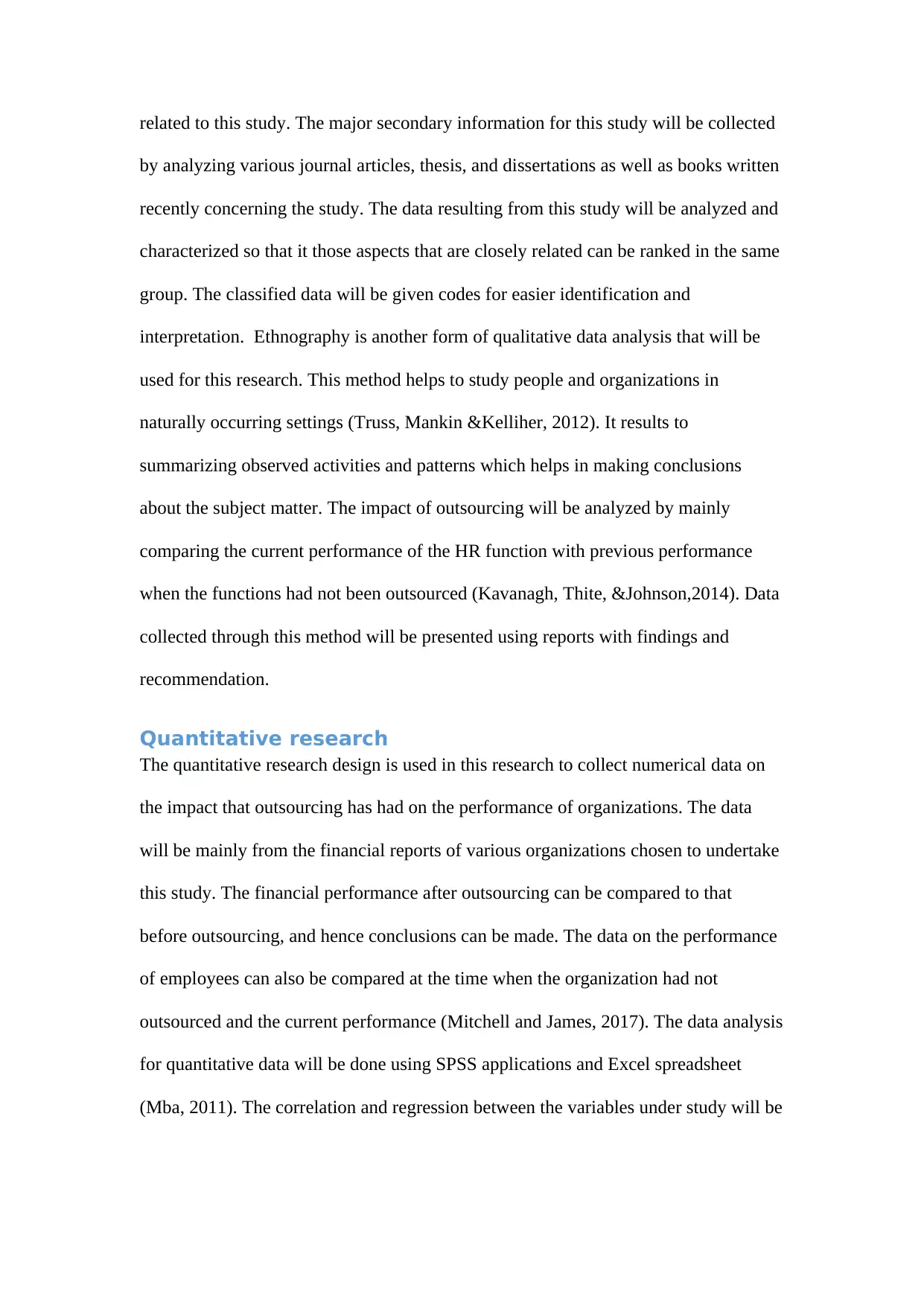
related to this study. The major secondary information for this study will be collected
by analyzing various journal articles, thesis, and dissertations as well as books written
recently concerning the study. The data resulting from this study will be analyzed and
characterized so that it those aspects that are closely related can be ranked in the same
group. The classified data will be given codes for easier identification and
interpretation. Ethnography is another form of qualitative data analysis that will be
used for this research. This method helps to study people and organizations in
naturally occurring settings (Truss, Mankin &Kelliher, 2012). It results to
summarizing observed activities and patterns which helps in making conclusions
about the subject matter. The impact of outsourcing will be analyzed by mainly
comparing the current performance of the HR function with previous performance
when the functions had not been outsourced (Kavanagh, Thite, &Johnson,2014). Data
collected through this method will be presented using reports with findings and
recommendation.
Quantitative research
The quantitative research design is used in this research to collect numerical data on
the impact that outsourcing has had on the performance of organizations. The data
will be mainly from the financial reports of various organizations chosen to undertake
this study. The financial performance after outsourcing can be compared to that
before outsourcing, and hence conclusions can be made. The data on the performance
of employees can also be compared at the time when the organization had not
outsourced and the current performance (Mitchell and James, 2017). The data analysis
for quantitative data will be done using SPSS applications and Excel spreadsheet
(Mba, 2011). The correlation and regression between the variables under study will be
by analyzing various journal articles, thesis, and dissertations as well as books written
recently concerning the study. The data resulting from this study will be analyzed and
characterized so that it those aspects that are closely related can be ranked in the same
group. The classified data will be given codes for easier identification and
interpretation. Ethnography is another form of qualitative data analysis that will be
used for this research. This method helps to study people and organizations in
naturally occurring settings (Truss, Mankin &Kelliher, 2012). It results to
summarizing observed activities and patterns which helps in making conclusions
about the subject matter. The impact of outsourcing will be analyzed by mainly
comparing the current performance of the HR function with previous performance
when the functions had not been outsourced (Kavanagh, Thite, &Johnson,2014). Data
collected through this method will be presented using reports with findings and
recommendation.
Quantitative research
The quantitative research design is used in this research to collect numerical data on
the impact that outsourcing has had on the performance of organizations. The data
will be mainly from the financial reports of various organizations chosen to undertake
this study. The financial performance after outsourcing can be compared to that
before outsourcing, and hence conclusions can be made. The data on the performance
of employees can also be compared at the time when the organization had not
outsourced and the current performance (Mitchell and James, 2017). The data analysis
for quantitative data will be done using SPSS applications and Excel spreadsheet
(Mba, 2011). The correlation and regression between the variables under study will be
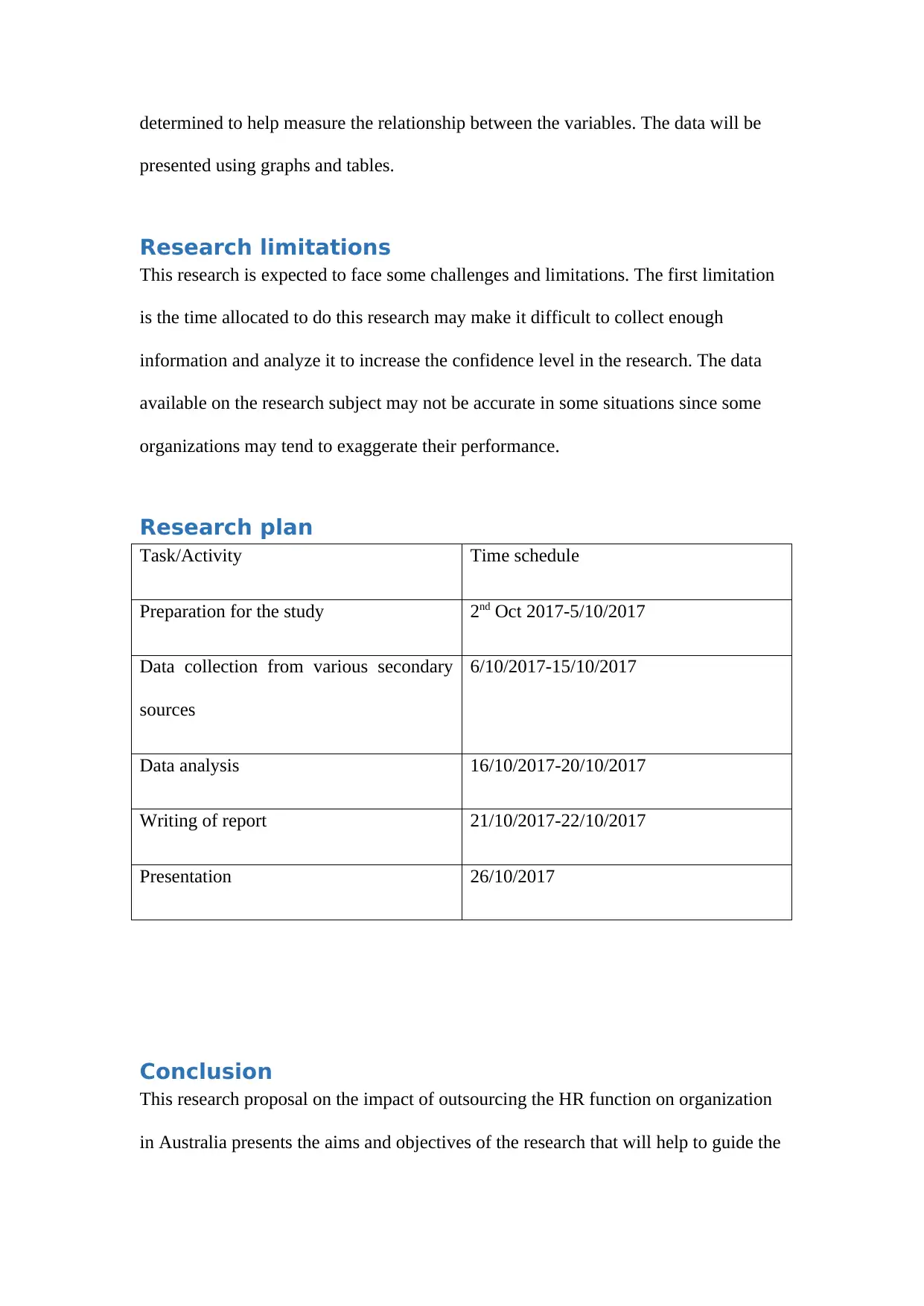
determined to help measure the relationship between the variables. The data will be
presented using graphs and tables.
Research limitations
This research is expected to face some challenges and limitations. The first limitation
is the time allocated to do this research may make it difficult to collect enough
information and analyze it to increase the confidence level in the research. The data
available on the research subject may not be accurate in some situations since some
organizations may tend to exaggerate their performance.
Research plan
Task/Activity Time schedule
Preparation for the study 2nd Oct 2017-5/10/2017
Data collection from various secondary
sources
6/10/2017-15/10/2017
Data analysis 16/10/2017-20/10/2017
Writing of report 21/10/2017-22/10/2017
Presentation 26/10/2017
Conclusion
This research proposal on the impact of outsourcing the HR function on organization
in Australia presents the aims and objectives of the research that will help to guide the
presented using graphs and tables.
Research limitations
This research is expected to face some challenges and limitations. The first limitation
is the time allocated to do this research may make it difficult to collect enough
information and analyze it to increase the confidence level in the research. The data
available on the research subject may not be accurate in some situations since some
organizations may tend to exaggerate their performance.
Research plan
Task/Activity Time schedule
Preparation for the study 2nd Oct 2017-5/10/2017
Data collection from various secondary
sources
6/10/2017-15/10/2017
Data analysis 16/10/2017-20/10/2017
Writing of report 21/10/2017-22/10/2017
Presentation 26/10/2017
Conclusion
This research proposal on the impact of outsourcing the HR function on organization
in Australia presents the aims and objectives of the research that will help to guide the
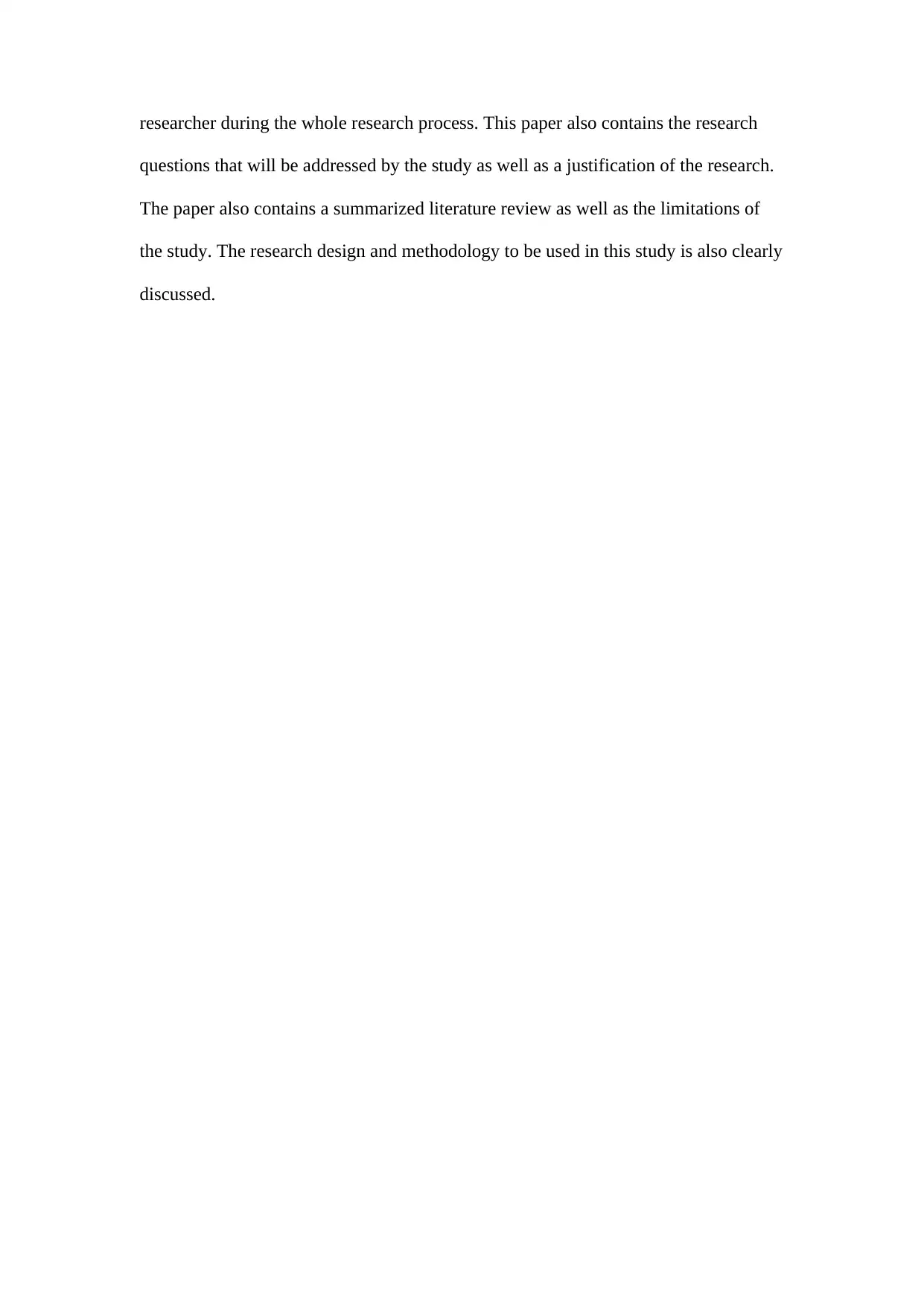
researcher during the whole research process. This paper also contains the research
questions that will be addressed by the study as well as a justification of the research.
The paper also contains a summarized literature review as well as the limitations of
the study. The research design and methodology to be used in this study is also clearly
discussed.
questions that will be addressed by the study as well as a justification of the research.
The paper also contains a summarized literature review as well as the limitations of
the study. The research design and methodology to be used in this study is also clearly
discussed.
Secure Best Marks with AI Grader
Need help grading? Try our AI Grader for instant feedback on your assignments.
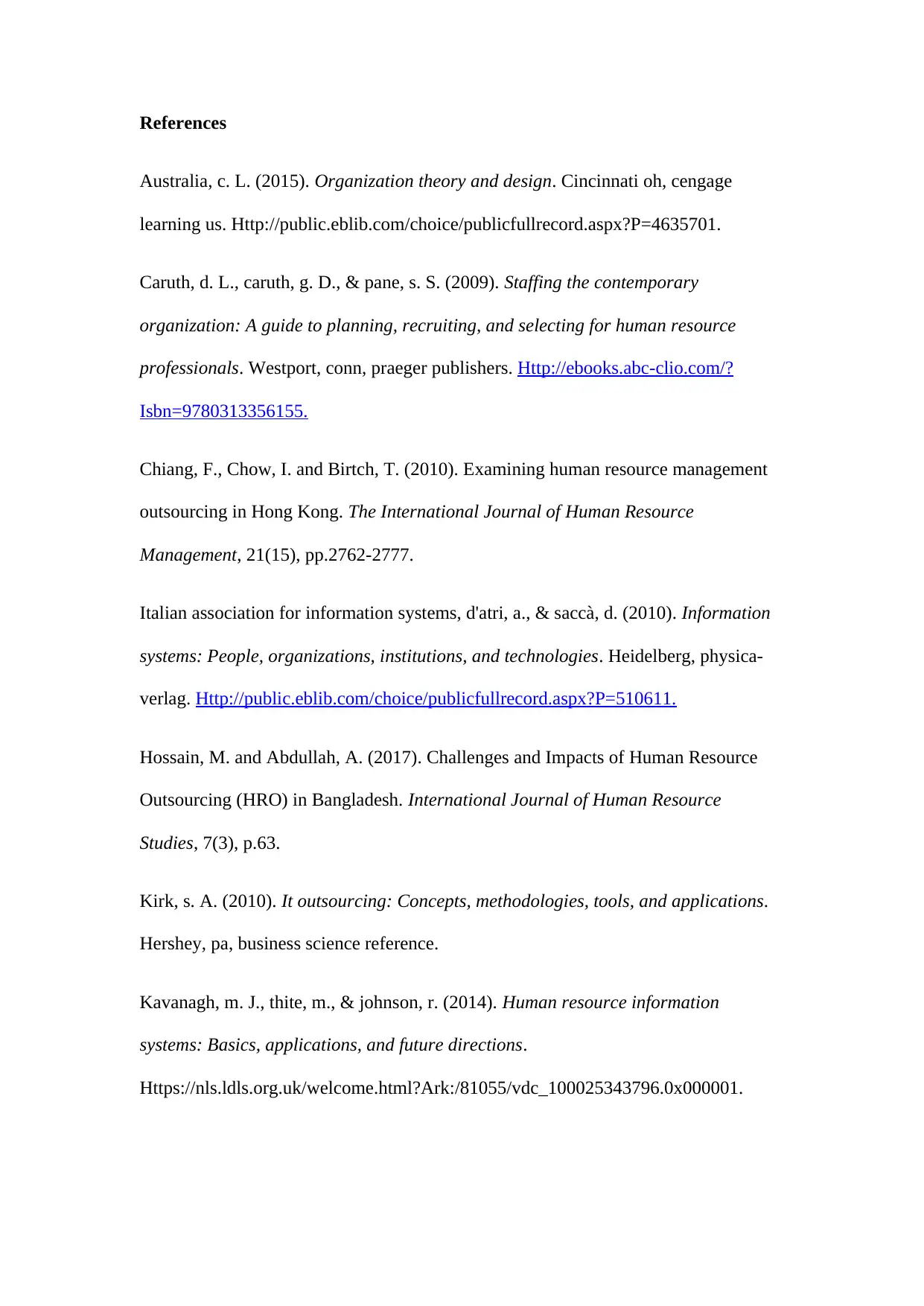
References
Australia, c. L. (2015). Organization theory and design. Cincinnati oh, cengage
learning us. Http://public.eblib.com/choice/publicfullrecord.aspx?P=4635701.
Caruth, d. L., caruth, g. D., & pane, s. S. (2009). Staffing the contemporary
organization: A guide to planning, recruiting, and selecting for human resource
professionals. Westport, conn, praeger publishers. Http://ebooks.abc-clio.com/?
Isbn=9780313356155.
Chiang, F., Chow, I. and Birtch, T. (2010). Examining human resource management
outsourcing in Hong Kong. The International Journal of Human Resource
Management, 21(15), pp.2762-2777.
Italian association for information systems, d'atri, a., & saccà, d. (2010). Information
systems: People, organizations, institutions, and technologies. Heidelberg, physica-
verlag. Http://public.eblib.com/choice/publicfullrecord.aspx?P=510611.
Hossain, M. and Abdullah, A. (2017). Challenges and Impacts of Human Resource
Outsourcing (HRO) in Bangladesh. International Journal of Human Resource
Studies, 7(3), p.63.
Kirk, s. A. (2010). It outsourcing: Concepts, methodologies, tools, and applications.
Hershey, pa, business science reference.
Kavanagh, m. J., thite, m., & johnson, r. (2014). Human resource information
systems: Basics, applications, and future directions.
Https://nls.ldls.org.uk/welcome.html?Ark:/81055/vdc_100025343796.0x000001.
Australia, c. L. (2015). Organization theory and design. Cincinnati oh, cengage
learning us. Http://public.eblib.com/choice/publicfullrecord.aspx?P=4635701.
Caruth, d. L., caruth, g. D., & pane, s. S. (2009). Staffing the contemporary
organization: A guide to planning, recruiting, and selecting for human resource
professionals. Westport, conn, praeger publishers. Http://ebooks.abc-clio.com/?
Isbn=9780313356155.
Chiang, F., Chow, I. and Birtch, T. (2010). Examining human resource management
outsourcing in Hong Kong. The International Journal of Human Resource
Management, 21(15), pp.2762-2777.
Italian association for information systems, d'atri, a., & saccà, d. (2010). Information
systems: People, organizations, institutions, and technologies. Heidelberg, physica-
verlag. Http://public.eblib.com/choice/publicfullrecord.aspx?P=510611.
Hossain, M. and Abdullah, A. (2017). Challenges and Impacts of Human Resource
Outsourcing (HRO) in Bangladesh. International Journal of Human Resource
Studies, 7(3), p.63.
Kirk, s. A. (2010). It outsourcing: Concepts, methodologies, tools, and applications.
Hershey, pa, business science reference.
Kavanagh, m. J., thite, m., & johnson, r. (2014). Human resource information
systems: Basics, applications, and future directions.
Https://nls.ldls.org.uk/welcome.html?Ark:/81055/vdc_100025343796.0x000001.
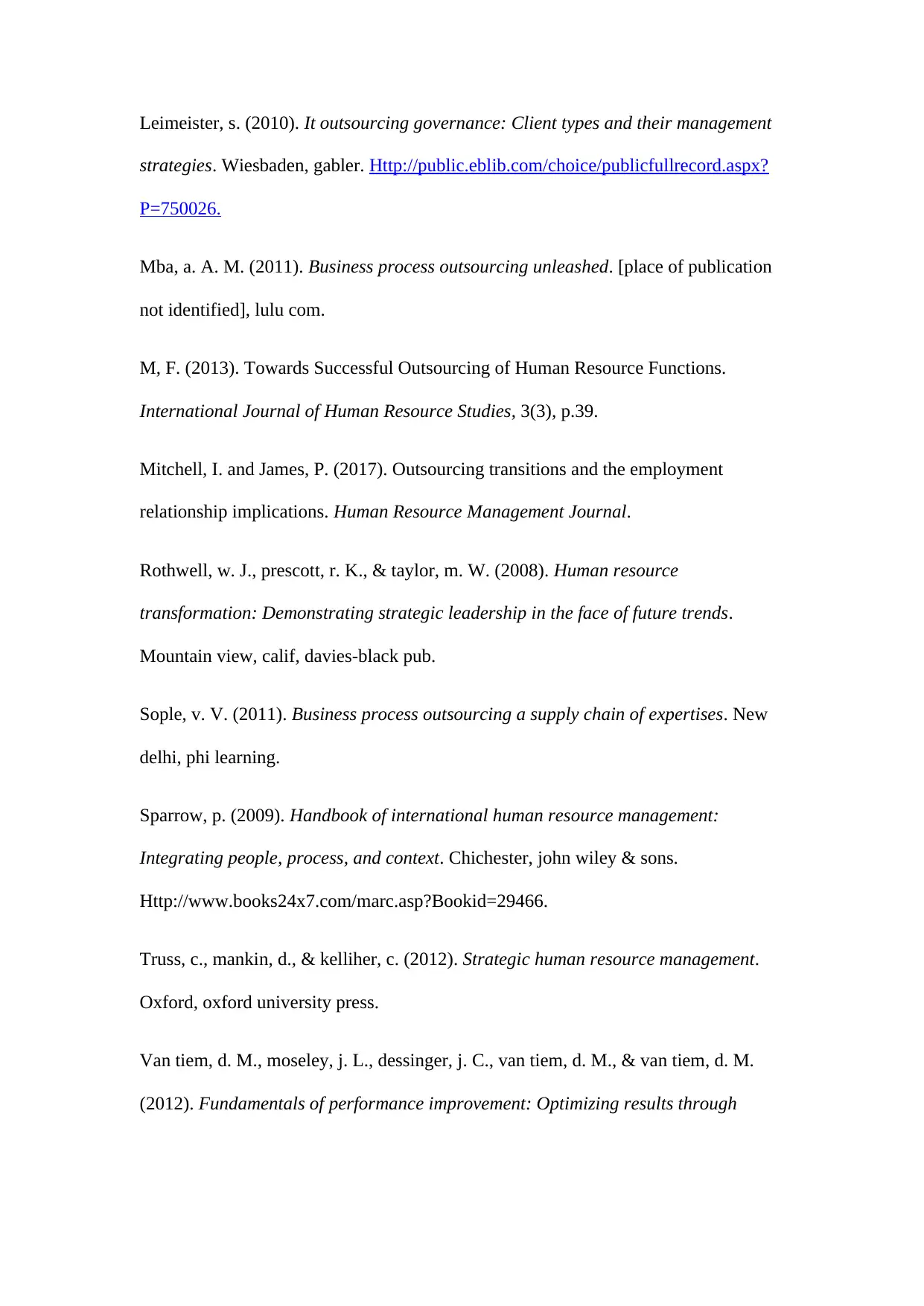
Leimeister, s. (2010). It outsourcing governance: Client types and their management
strategies. Wiesbaden, gabler. Http://public.eblib.com/choice/publicfullrecord.aspx?
P=750026.
Mba, a. A. M. (2011). Business process outsourcing unleashed. [place of publication
not identified], lulu com.
M, F. (2013). Towards Successful Outsourcing of Human Resource Functions.
International Journal of Human Resource Studies, 3(3), p.39.
Mitchell, I. and James, P. (2017). Outsourcing transitions and the employment
relationship implications. Human Resource Management Journal.
Rothwell, w. J., prescott, r. K., & taylor, m. W. (2008). Human resource
transformation: Demonstrating strategic leadership in the face of future trends.
Mountain view, calif, davies-black pub.
Sople, v. V. (2011). Business process outsourcing a supply chain of expertises. New
delhi, phi learning.
Sparrow, p. (2009). Handbook of international human resource management:
Integrating people, process, and context. Chichester, john wiley & sons.
Http://www.books24x7.com/marc.asp?Bookid=29466.
Truss, c., mankin, d., & kelliher, c. (2012). Strategic human resource management.
Oxford, oxford university press.
Van tiem, d. M., moseley, j. L., dessinger, j. C., van tiem, d. M., & van tiem, d. M.
(2012). Fundamentals of performance improvement: Optimizing results through
strategies. Wiesbaden, gabler. Http://public.eblib.com/choice/publicfullrecord.aspx?
P=750026.
Mba, a. A. M. (2011). Business process outsourcing unleashed. [place of publication
not identified], lulu com.
M, F. (2013). Towards Successful Outsourcing of Human Resource Functions.
International Journal of Human Resource Studies, 3(3), p.39.
Mitchell, I. and James, P. (2017). Outsourcing transitions and the employment
relationship implications. Human Resource Management Journal.
Rothwell, w. J., prescott, r. K., & taylor, m. W. (2008). Human resource
transformation: Demonstrating strategic leadership in the face of future trends.
Mountain view, calif, davies-black pub.
Sople, v. V. (2011). Business process outsourcing a supply chain of expertises. New
delhi, phi learning.
Sparrow, p. (2009). Handbook of international human resource management:
Integrating people, process, and context. Chichester, john wiley & sons.
Http://www.books24x7.com/marc.asp?Bookid=29466.
Truss, c., mankin, d., & kelliher, c. (2012). Strategic human resource management.
Oxford, oxford university press.
Van tiem, d. M., moseley, j. L., dessinger, j. C., van tiem, d. M., & van tiem, d. M.
(2012). Fundamentals of performance improvement: Optimizing results through
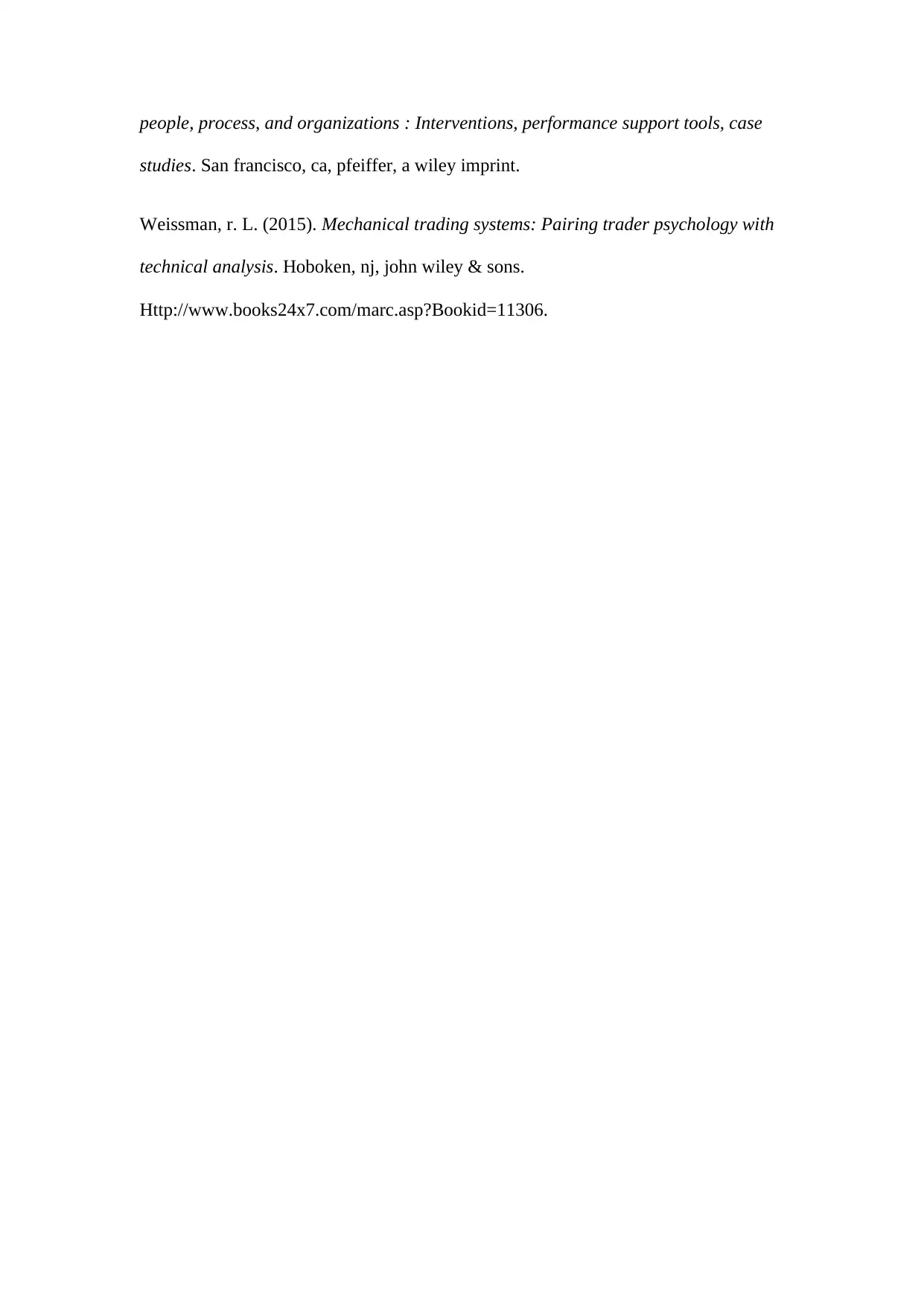
people, process, and organizations : Interventions, performance support tools, case
studies. San francisco, ca, pfeiffer, a wiley imprint.
Weissman, r. L. (2015). Mechanical trading systems: Pairing trader psychology with
technical analysis. Hoboken, nj, john wiley & sons.
Http://www.books24x7.com/marc.asp?Bookid=11306.
studies. San francisco, ca, pfeiffer, a wiley imprint.
Weissman, r. L. (2015). Mechanical trading systems: Pairing trader psychology with
technical analysis. Hoboken, nj, john wiley & sons.
Http://www.books24x7.com/marc.asp?Bookid=11306.
1 out of 13
Related Documents
Your All-in-One AI-Powered Toolkit for Academic Success.
+13062052269
info@desklib.com
Available 24*7 on WhatsApp / Email
![[object Object]](/_next/static/media/star-bottom.7253800d.svg)
Unlock your academic potential
© 2024 | Zucol Services PVT LTD | All rights reserved.





